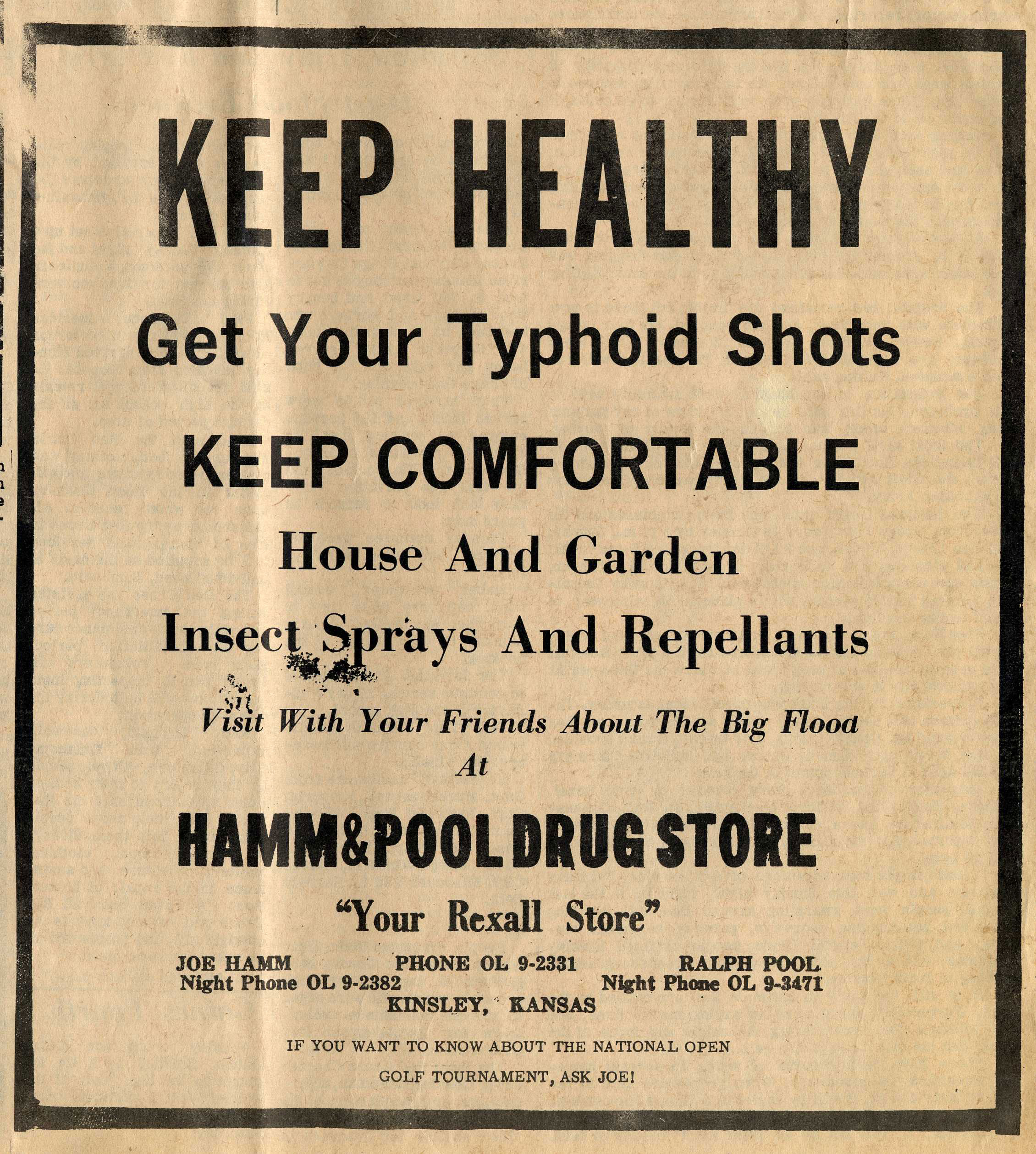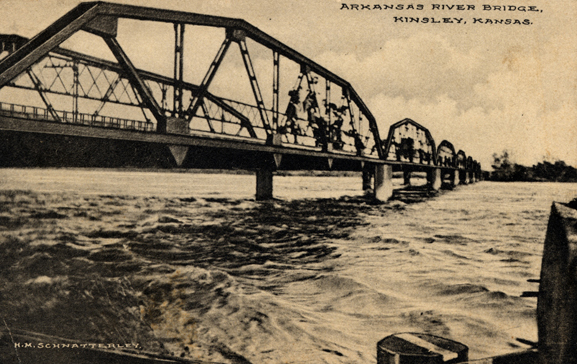This Sunday at 2 p.m. at the Palace Theater in downtown Kinsley will be the premier showing of the Kansas Humanities Council’s Turning Points: Stories of Change featuring “Navigating Rough Waters.” This is Kinsley’s very own story of living on the floodplain. You won’t want to miss seeing your friends and neighbors on the big screen, enjoying the free popcorn, viewing another short film about the 1965 Arkansas River Flood in Offerle, and having your questions about FEMA regulations and Flood Insurance answered by a panel of experts. Mark you calendar. Navigating Rough Waters
Panel to answer questions
Following the Turning Points film premiere, there will be a panel discussion to try to answer everyone’s questions about FEMA regulations and Flood Insurance as they affect Kinsley today. The panel will consist of: Steve Samuelson, National Flood Insurance Program Specialist; Jay Dill, current Kinsley City Manager; and Marsha Bagby, past Kinsley City Manager. These people should be able to clear up any misconceptions and maybe even give us some ideas about projects which might help us move forward.
At the premiere, I plan on having a big display on the history of flooding in Kinsley. It will feature lots of pictures, quotes from the citizens that were interviewed for the film, newspaper images and other documents of interest. So mark October 26, 2 p.m. on your calendar and get ready for popcorn and seeing your neighbors on the big screen.
Don’t miss the premiere
Turning Points: Stories of Change will be the feature film at 2 p.m. on October 26 at the Palace Theater in downtown Kinsley. Eric McHenry of Washburn University in Topeka will be in attendance to introduce the film for the Kansas Humanities Council. This project explores pivotal moments in four Kansas Communities: Kinsley, Hays, Ulysses, and Olathe. Dr. McHenry wrote and narrates the connecting thread that ties the films together.
The film was produced by Gizmo Pictures of Topeka. Our contribution, “Navigating Rough Waters,” has comments by Kinsley citizens about floods and the challenges of living on a flood plain taken from interviews conducted in January of this year. It also draws on historic photographs, film and newspaper articles. It was a difficult task telling the complicated story of our struggle and triumphs in a very short film, but I think Gizmo Pictures have managed to do it. Be sure to put this date on your calendar.
“The Chickens Survived”
“My dad was down watching the river. He said that when it came in, it wasn’t rising very fast, but then all at once, there came the trees and the logs and the dead cattle. It just made a wall; it was just a dam moving slow.” Kermit Froetschner
Our film premiere on October 26 will begin with a short introductory film about the Arkansas River flood waters raging through Offerle on its way to Kinsley in June, 1965. This film was produced by Rachel Harmon of Sagebrush Video and is entitled, “The Chickens Survived” Community & Cooperation – Offerle and the Flood of 1965. The script was inspired from a gathering last March of Offerle citizens who met to remember the flood. Rachel had a particular interest in this project as her grandparents were Leander and Pauline Lightcap from south of Offerle. Rachel has produced many full-length videos about Kansas history including two on the Trousdale area. All of her videos are available at the library for check out. ”The Chickens Survived” was also funded as a special project by the Turning Points: Stories of Change grant the Kinsley Library received from the Kansas Humanities Council. More tomorrow about the KHC feature film.
Now the 1965 Offerle flood stories will be recorded
During our interviews for the upcoming KHC film project, Navigating Rough Waters, we heard stories about the 1965 flood waters raging south of Offerle towards Kinsley. Many told of how the farmers worked together to harvest the wheat before the river flooded the fields. Others credited the cut straw in the fields and the debris dams created by it with spreading out the water and saving Kinsley from a worst disaster.
These stories sparked the interest of Offerle resident Dr. Galen Boehme who encouraged us to find a way to record these memories also. I contacted Rachel Lightcap Harmon of Sagebrush Production and former Offerle resident. She met with Dr. Boehme and myself to explore how this could be done.
The results is a gathering has been planned for Saturday, March 29 from 2-4 p.m. at Zion Lutheran Church. All the local folk are invited to come together as a group to share their stories and memories which Rachel will record on film. We appreciate the continued support of the Kansas Humanities Council in this companion project for the premiere of Navigating Rough Waters.
If the Offerle folk enjoy this experience, Rachel will be exploring the possibility of creating a video that records that area’s history similar to the South of the Parallel videos that feature the Trousdale, Fellsburg, and Centerview area. It sure is exciting when local people find ways they can become involved in preserving the heritage of the area. Hope to see everyone at the Zion Church on March 29th.
Flooding and Typhoid

Hamm and Pool Drug Store Ad depicts what is important after a flood: typhoid shots, bug control, and Big Flood stories.
One aspect of flooding that has come up in the research and interviews which I had not thought about was the prevention of typhoid fever. Typhoid is a human disease which is spread by ingesting water contaminated by human waste. This happens during flooding when sewer lines fill and back up and waste water treatment facilities are flooded. Whenever there was a flood in Kinsley, everyone was encouraged to have a typhoid shot. During her interview, Mary Kallaus told a cute story of how she went to the courthouse to see about getting a shot. She discretely went up to the doctor and asked if she should get one as she was in the early months of pregnancy. He replied that of course she should and “go get in the line over there for children and pregnant women.” After that, everyone in town knew she was pregnant.
June 9, 1921 Flood
The end of this month, the Gizmo Production crew will visit Kinsley to film our story of living on the floodplain. I have spent the day looking up newspaper articles on the bigger floods that this area has experienced in 1921, 1942, 1965, 1971, 1973, and 1996. If anyone has pictures or stories about flooding, don’t forget to share it with the library for possible inclusion in the finished film and as a definite addition to our archives.
An article which brought to mind Noah and his flood was in the Kinsley Mercury of June 16, 1921. It reported on the June 9 flood that “Every flood brings a revival of boat building, and this one has been no exception.” One skiff that was built made several experimental trips down the river. “All went well till they got to the Fred Fletcher place when they hit an obstruction and capsized. However, as the water was only about four feet deep they rescued themselves and their craft. The plan on which this good ship was operated was very simple. The current was too swift for upstream navigation, so the party would voyage downstream to some convenient point then load and go back up the stream and start again.”
It was also reported that another group of citizens “have built the most pretentious boat that has ever been built in this section. It is 20 feet long with 5 ¾ beam. They have installed a four cylinder Reo motor. It has capacity for about 8 adults. They plan trips on the Arkansas and expect to develop enough power to come back against the current after going downstream. They launched their craft Sunday and after a few experimental trips, carried passengers for a small fee and did a good business.”
Flood waters over a mile wide
Remember when radio was the link to breaking local news? That was the way it was 48 ½ years ago on Sunday night, June 19, 1965, when Kinsley Mayor Jim Heinz spoke over radio station KGNO at Dodge City, declaring a state of emergency. The rampaging Arkansas River would soon hit the city over a mile south of its natural banks.
Darkness increased the anxiety as no one was able to see the water until it was quite close. Floodwaters reached the south edge of the city limits about 12:45 a.m., spreading out over the airport and the football field. By 3 a.m. water began spilling over US Hwy 50 near the bowling alley. Mayor Heinz ordered the evacuation of the southeast part of the city.
The big water hit at 4 a.m. flooding the city south of the railroad tracks in about ½ hour. Flood waters ranged from 6” to 4’. Strong currents swept through the streets carrying logs and other debris. Stiff winds pushed the water through the city and maintained its peak throughout Monday. Highways were closed, the hospital and nursing home evacuated.
This was by far the worst flood in memory and there would never be another like it to date. But it and subsequent flooding of the Coon Creeks in the 1970’s would lead the city to seek solutions to flooding issues. Stay tuned for more interesting facts and tidbits about how Kinsley has been “Navigating Rough Waters” since 1965.
Sorry for mistake
I see I made a typing mistake and used the inch symbol instead of the foot symbol. Sorry, I didn’t catch that when I proofread. It should have been 3.8’ (feet) to 17.2’ (feet) in 15 minutes. That looks more like a flood doesn’t it?
The Great Flood of 1965 – Do You Remember?
I’m looking at a Hutchinson News special edition dated July 4, 1965 which reads, “They’ll never forget the Granddaddy of Ark Floods,” and I am wondering how many of you do remember it 48 years later? It all started on June 14, 1965 in Colorado with torrential rains, wind and a tornado. For 3 days it rained and the tributaries flooded into the Arkansas River and raced east dealing death and destruction from La Junta on into all the western Kansas towns and cities along the river. The waters reached Dodge City on June 19 and observers reported that it rose from 3.8” to 17.2” in 15 minutes. About 1500 residents had to evacuate the area. Now the river was pregnant with the tons of debris it had picked up on its 270-mile route when it reached Kinsley the morning of June 21. The Arkansas River flooding was exacerbated by Coon Creek whose water backed up into the city blocking highways from 3 directions.
I’ll be telling you more about this flood in the days to come, as it will be the beginning of our film’s story. We are very lucky to be able to include actual movie footage of the 1965 flood taken from the top of the elevator by Marvin Ryan. That is just one of the exciting aspect of this project as it seeks to rescue and preserve the memories, images and document which record the flooding issues as Turning Points in Kinsley’s history. Perhaps your memory or photo album can contribute to our understanding of this flood and any subsequent ones or the many attempts of the city to meet the challenges of living in a flood plain.

